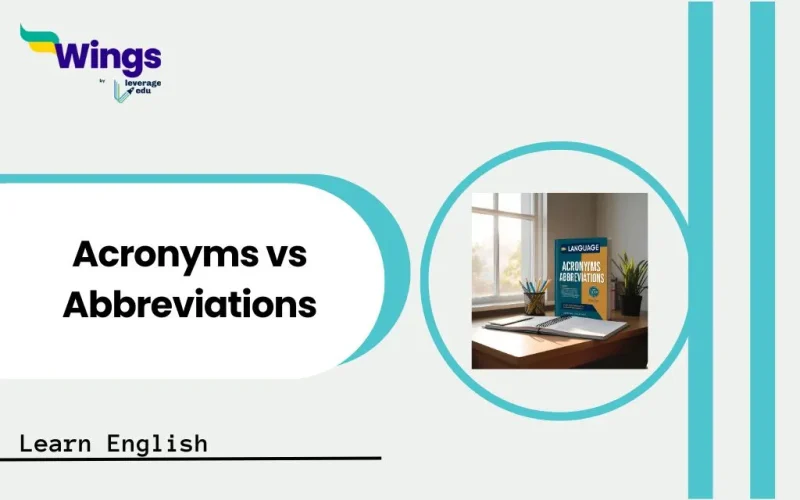Acronyms and abbreviations are both shortened forms of words or phrases used to make communication quicker and easier. Acronyms are made from the first letters of multiple words and are often pronounced as new words. Abbreviations, however, are general shortenings of words or phrases. Understanding the difference between the two helps in improving the clarity in both writing and speech. In this article, we will define each term and highlight key differences between acronyms vs abbreviations for better understanding.
This Blog Includes:
What is an Acronym and an Abbreviation?
Definition of Acronym: Acronyms and abbreviations are both used to shorten long words or phrases, but they work differently. An acronym is made by taking the first letters of several words and forming a new, pronounceable word.
For example:
- NASA stands for National Aeronautics and Space Administration
- SCUBA stands for Self-Contained Underwater Breathing Apparatus
Definition of Abbreviation: An abbreviation is a shortened form of a single word or a phrase. It may include just part of the word or a few letters.
For instance:
- Dr. for Doctor
- Feb. for February
- km for kilometer.
Explore: Can You Guess These Common Abbreviations?
Acronyms vs Abbreviations
While acronyms and abbreviations serve the same purpose, understanding the difference between them is important. This helps in using them correctly, especially in academic, professional, and formal writing.
Now, let us understand acronyms vs abbreviations through the following points:
| Point of Difference | Acronyms | Abbreviations |
| Method of Formation | Acronyms are formed specifically by combining the initial letters of multiple words to create a new pronounceable word. | Abbreviations encompass any shortened form of a word or phrase, representing a broader category of word shortenings. |
| Pronunciation Approach: | Acronyms are typically pronounced as single, complete words. Example: NASA is pronounced as nah-suh. | Abbreviations are often pronounced as the full original word or as individual letters. Example: Dr. is pronounced as doctor. |
| Use of Punctuation | Acronyms rarely use periods between letters. Example: NATO, UNICEF, LASER | Abbreviations frequently use periods to indicate shortened words. Example: Mr., Ph.D. |
| Requirement of Source Word | Acronyms must be formed from multiple words, taking at least one letter from each word in the original phrase. | Abbreviations can be created from a single word by removing some of its letters Example: app from application, exam from examination. |
| Linguistic Integration | Acronyms often become recognised as independent words in everyday language, sometimes with people forgetting they were originally abbreviations. | Abbreviations generally maintain a clear connection to their original words and are recognized as shortened forms rather than new words. |
| Capitalisation Conventions: | Acronyms are typically written in all capital letters, though some common ones have transitioned to lowercase over time. Example: Laser, scuba | Abbreviations follow various capitalisation rules depending on their usage. Example: Title Case (Jan.), Lowercase (etc.), or All caps (USA). |
| Historical Development | Acronyms are a relatively modern linguistic development, becoming particularly common during the 20th century with government agencies and technology. | Abbreviations have ancient origins, with examples dating back to classical civilizations and medieval manuscript traditions. |
| Intent of Creation | Acronyms are often created intentionally to form a memorable or pronounceable word. Example: MADD for Mothers Against Drunk Driving). | Abbreviations typically evolve organically as natural shortenings without consideration for creating new words |
| Recursive Capability | Acronyms can sometimes be recursive, where one of the letters in the acronym stands for the acronym itself. Example: GNU stands for GNU’s Not Unix | Abbreviations do not feature recursive properties as they are direct shortenings of specific words or phrases. |
| Naming Function | Acronyms often serve as official names for organizations, procedures, or systems. Example: NATO, UNICEF, SWIFT | Abbreviations are more commonly used for everyday communication convenience rather than official naming purposes. |
| Definition Requirement | Acronyms create new lexical items that may require definition when first introduced in a text. | Abbreviations typically represent common words that readers can easily recognize without additional explanation. |
| Composition of Character | Acronyms can sometimes incorporate numbers and symbols into their structure For example: P2P for peer-to-peer, C4ISR for Command, Control, Communications, Computers, Intelligence, Surveillance and Reconnaissance | Abbreviations typically only use letters from the original word, though they may include periods or apostrophes as punctuation. |
| Requirement of Pronunciation | Acronyms must be at least partially pronounceable as words to be true acronyms (as opposed to initialisms like FBI, which are pronounced as individual letters). | Abbreviations have no pronunciation requirements and can be spoken in various ways depending on convention and context. |
| Strategic Purpose: | Acronyms often serve branding and marketing purposes, creating distinctive and memorable names for products or organisations. | Abbreviations primarily serve practical communication purposes rather than branding objectives. |
| Semantic Evolution | Acronyms can sometimes take on meanings entirely separate from their original phrases, developing their own semantic identities. | Abbreviations generally retain direct semantic connections to their source words without developing independent meanings. |
Explore: Capitalization Rules: A Comprehensive Guide for English Students
Difference between Abbreviations and Acronyms in PDF Format
The PDF format given below clearly highlights the key differences between acronyms vs abbreviations. It helps readers understand their formation, usage, and purpose with easy examples. Ideal for students and professionals, it serves as a quick and helpful reference guide.
While acronyms and abbreviations both shorten words or phrases, the difference between acronyms and abbreviations serves different purposes to clarify their use in their respective correct places. Acronyms form new, pronounceable words, while abbreviations are shorter versions of existing words. Knowing how to tell them apart helps us use language more clearly and correctly, whether we are writing for school, work, or everyday life.
Also Read: Period Punctuation Mark (.): Usage, Rules and Examples
FAQs
Ans. An abbreviation is a shortened form of a word or phrase, while an acronym is a type of abbreviation made using the first letters of a group of words, and it is usually pronounced as a word (like NASA).
Ans. KFC is an abbreviation, not an acronym, because it is said as individual letters K-F-C and not as a word.
Ans. OMG is an abbreviation, often referred to as an initialism, because we pronounce each letter separately O-M-G.
Ans. OMG is an abbreviation, often referred to as an initialism, because we pronounce each letter separately O-M-G.
Ans. CEO is an abbreviation, specifically an initialism, as we pronounce each letter separately C-E-O.
Explore the different topics of Learn English here:
We hope this blog on Acronyms vs Abbreviations was informative and helped you improve your English skills. You can also follow the Learn English page of Leverage Edu for more exciting and informative blogs related to English grammar and the English language.
 One app for all your study abroad needs
One app for all your study abroad needs















 45,000+ students trusted us with their dreams. Take the first step today!
45,000+ students trusted us with their dreams. Take the first step today!


